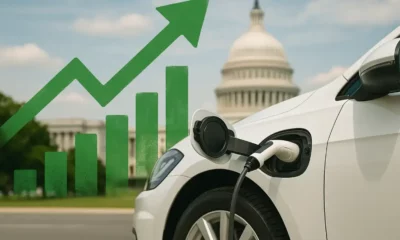Choosing the Right Electric Vehicle: The Ultimate Guide for Families
Choosing the Right Electric Vehicle: The Ultimate Guide for Families
Estimated reading time: 12 minutes
Key Takeaways
- Assess your family’s specific needs (size, range, cargo) before looking at EV models.
- Prioritize advanced safety features and check official safety ratings (IIHS, NHTSA).
- Understand your realistic daily and occasional long-distance EV range requirements to avoid overspending or range anxiety.
- Calculate the total cost of ownership, factoring in purchase price, incentives (federal, state, local), fuel savings, and lower maintenance.
- Explore top family-friendly EV models like the Tesla Model Y, Kia EV9, Hyundai Ioniq 5, VW ID.4, and Ford Mustang Mach-E, comparing their features.
- Consider practicalities like home charging installation, public charging availability, maintenance needs, and performance in different weather conditions.

Table of contents
- Understand Your Family’s Needs When Choosing an Electric Vehicle
- Prioritize Safety Features in Family-Friendly EVs
- Understand EV Range Needs for Your Electric Vehicle
- Plan Your EV Budget Carefully
- Explore Top Family-Friendly EV Models
- Consider Practical Aspects of Owning Electric Vehicles as Family Cars
- Maximize Your EV Budget with Incentives and Long-Term Savings
- Making the Final Decision When Choosing the Right Electric Vehicle
- Conclusion: Your Family’s Journey to Electric Driving
- Bonus: Common Questions About Family Electric Vehicles Answered
The world of family cars is changing fast! More and more families are looking at electric vehicles (EVs). In fact, the number of electric cars on the road is growing rapidly, showing a big shift in how families choose their main vehicle. Picking the best electric car for your family, or choosing the right electric vehicle, is now a big decision for many parents.
“Gone are the days when electric cars were just a niche idea. Today, they are a real, practical choice for busy households, replacing traditional gas-powered cars.”
Why the switch? Electric vehicles offer great benefits for families. They are better for the environment, can save you money on gas and repairs, and often come packed with the latest technology. This aligns with the broader movement towards Sustainable Tech: Powering a Greener Future Through Innovation.
This article is your friendly guide. We will walk you through everything you need to know about choosing the right electric vehicle for your family’s specific needs, making the process clear and simple.
Understand Your Family’s Needs When Choosing an Electric Vehicle
Before you start looking at shiny new electric vehicles, the first step in choosing the right electric vehicle is figuring out exactly what your family needs. Think about your daily life and how you use your car.
Ask yourselves these important questions:
- How far do we drive each day? Think about trips to school, work, activities, and grocery runs. What’s your usual weekly mileage?
- How many people are in our family? Do you need space for multiple kids? How many car seats do you need to fit comfortably and safely?
- What do we need to carry? Consider space for strollers, sports gear, luggage for trips, or big grocery hauls. Does the trunk (or maybe even a ‘frunk’ – front trunk!) have enough room?
- Do we have any special needs? Does anyone need extra help getting in or out? Do you travel with pets often?
Thinking about these points helps you understand what size car you need, how much EV range (how far it can go on one charge) is necessary, and what special features might make life easier.
Quick Needs Checklist:
- [ ] Number of seats needed: ______
- [ ] Number of car seats needed: ______
- [ ] Main use (daily commute, trips, etc.): ______________
- [ ] Average daily miles: ______
- [ ] Need lots of cargo space? (Yes/No)
- [ ] Need space for pets? (Yes/No)
- [ ] Need special accessibility? (Yes/No)
- [ ] Do we take frequent long road trips? (Yes/No)
Answering these helps paint a picture of your ideal family-friendly EV. For example, a family mostly doing short city drives might prioritize space over maximum EV range, while a family that loves road trips will need a car that can go farther on a charge. Understanding these needs is key to finding the perfect match among the many available electric vehicles.
Prioritize Safety Features in Family-Friendly EVs
When you’re carrying precious cargo like your kids, nothing is more important than safety. Good news: many family-friendly EVs are packed with advanced safety features. Making sure your chosen electric car is safe should be top of your list.
Look for these key safety features in potential family cars:
- Forward Collision Warning (FCW): This system warns you if you’re getting too close to the car in front of you and might crash.
- Automatic Emergency Braking (AEB): If the FCW system senses a crash is about to happen, AEB can automatically apply the brakes to help stop the car or reduce the impact.
- Blind-Spot Monitoring: Sensors watch the spots you can’t easily see in your mirrors and alert you if a car is there, especially helpful when changing lanes.
- Lane Departure Warning: This alerts you if your car starts drifting out of its lane without signaling.
- Lane-Keeping Assist: This goes a step further and gently steers the car back into the lane if you start to drift.
- Adaptive Cruise Control: This system keeps a set distance from the car ahead, automatically slowing down or speeding up with the flow of traffic.
- Child Seat Compatibility (LATCH): Make sure the car has easy-to-use LATCH anchors for securely installing child safety seats. Check how many seats can fit across the back.
Always check safety ratings from trusted organizations like the Insurance Institute for Highway Safety (IIHS) and the National Highway Traffic Safety Administration (NHTSA). Many family-friendly EVs perform very well in crash tests. For example, models like the Hyundai Ioniq 5, Volkswagen ID.4, and Nissan Ariya have earned top safety awards, making them excellent choices for safety-conscious families [Source: Research finding 17].
“Electric vehicles often have a built-in safety advantage too. The heavy battery pack is usually placed low down in the floor of the car. This gives the car a lower center of gravity, making it less likely to roll over and improving stability on the road.”
Choosing a car with strong safety features gives you peace of mind on every journey.
(Source used in this section: Research finding 17 – specific models mentioned as examples)
Understand EV Range Needs for Your Electric Vehicle
One of the biggest questions people have about electric vehicles is “How far can it go on a single charge?” This is called EV range, and it’s a really important factor when choosing the right electric vehicle for your family. To understand more about the technology that powers this range, you might be interested in reading about The Latest Advances in Battery Technology for EVs: A 2025 Update.
The good news is that EV range keeps getting better! The typical, or median, range for new fully electric cars sold today is around 250 miles. This is often more than enough for most families’ daily needs.
How Much Range Do You Really Need?
- Daily Driving: Think about your busiest driving day of the week. How many miles is that? For most families, daily driving involves school runs, work commutes, and errands, often adding up to less than 50 miles. An EV range of 250-300 miles is usually plenty for covering several days of typical driving without needing a charge [Source: Research finding 14].
- Calculating Your Needs: Look at your weekly mileage. Let’s say you drive about 200 miles a week. An EV with 250 miles of range means you might only need to charge once or twice a week at home. It’s smart to choose a car with a bit more range than your absolute minimum need, giving you a buffer for unexpected trips or colder weather (which can reduce range slightly).
- Range Anxiety: Feeling nervous about running out of charge is common, but it’s often called “range anxiety.” The reality is, with a bit of planning (like charging at home overnight), most drivers rarely get close to using their full range day-to-day. Knowing your car’s capabilities and where charging stations are helps ease this worry.
“Range anxiety is real, but often overestimated. With home charging and improving public networks, most families find EV range more than sufficient for daily life.”
What About Road Trips?
This is where slightly longer EV range can be helpful. If your family loves vacations and long drives, look for models offering 300+ miles of range. Also, check how fast the car can charge. Many newer electric vehicles support DC fast charging, which can add hundreds of miles of range in just 20-30 minutes at a public fast-charging station. Planning your route using apps that show charging stations makes road trips smooth.
Remember, factors like extreme cold or heat, driving speed (higher speeds use more energy), and using the heater or air conditioning can affect your actual EV range. But modern electric vehicles are designed to handle these things, and understanding how they impact range helps you plan effectively.
(Sources used in this section: https://evco.colorado.gov/get-the-facts/an-ev-for-you, Research finding 14)
Plan Your EV Budget Carefully
Thinking about money is a big part of buying any car. When considering family-friendly EVs, it’s important to look at the whole EV budget, not just the price tag. While some electric vehicles might seem more expensive upfront than similar gas cars, they can save you money in the long run. For deeper insight into managing your EV costs, explore guides like EV Charging 101: Costs, Home Stations, and How to Save with Rebates.
Here’s a breakdown of costs to include in your EV budget:
- Purchase Price: This is the main sticker price. Compare different models and trim levels.
- Long-Term Savings: Think about money saved on fuel (electricity is usually cheaper than gas) and maintenance (EVs have fewer moving parts, no oil changes!).
- Tax Credits: The U.S. government offers a federal tax credit of up to $7,500 for qualifying new electric cars, and sometimes for used ones too. This can significantly lower the real cost. (Check current rules as they change).
- State and Local Incentives: Many states, cities, and even utility companies offer extra rebates or tax credits for buying an EV or installing a home charger. Research what’s available where you live! Don’t forget to investigate resources like Your Complete Guide to Solar Energy Tax Credits, as similar incentives might apply to EVs depending on your location.
- Home Charging Costs: You’ll likely want a Level 2 charger installed at home for faster, convenient charging. Factor in the cost of the charger and installation (which might also have rebates).
- Insurance: EV insurance costs are often similar to gas cars, but it’s good to get quotes as it can vary. Some insurers offer discounts for safety features common in EVs.
Lower Running Costs:
One of the biggest financial benefits of electric vehicles is their lower running costs. You’ll save money every time you charge instead of filling up with gas. Plus, EVs need less maintenance. There are no oil changes, spark plugs, exhaust systems, or many other parts that need fixing on gas cars [Source: https://evpowered.co.uk/features/best-family-electric-cars-the-top-10-evs-for-families-from-ford-to-vw/].
“Look beyond the sticker price! The true cost of owning an EV often becomes lower than a gas car over time due to significant savings on fuel and maintenance.”
Example: 5-Year Cost Comparison (Illustrative)
Let’s imagine comparing a typical family EV SUV to a similar gas SUV over 5 years. This is just an example, your costs will vary:
| Cost Factor | Electric SUV Example | Gas SUV Example |
|---|---|---|
| Purchase Price | $45,000 | $35,000 |
| Federal Tax Credit | -$7,500 | $0 |
| State Rebate (Est.) | -$2,000 | $0 |
| Net Upfront Cost | $35,500 | $35,000 |
| Fuel (5 Years)* | $3,500 | $9,000 |
| Maintenance (Est.) | $1,500 | $4,000 |
| Total Over 5 Yrs | $40,500 | $48,000 |
This simple comparison shows how, even if the initial price is higher, the lower running costs of an EV can make the total cost of ownership cheaper over time. Planning your EV budget carefully helps you see the full financial picture of choosing a family-friendly EV.
(Source used in this section: https://evpowered.co.uk/features/best-family-electric-cars-the-top-10-evs-for-families-from-ford-to-vw/)
Explore Top Family-Friendly EV Models
Now for the fun part: looking at some specific EV models that are great choices for families! These family-friendly EVs often score well on safety, offer good range, have practical features for family cars, and are popular choices among parents switching to electric vehicles.
Here are a few top picks to consider:
1. Tesla Model Y
- Price Range: Starts around $45,000 (check current pricing).
- Range: Excellent range, often over 300 miles depending on the version.
- Safety: Consistently earns top safety ratings. Comes with Tesla’s advanced Autopilot driver-assistance features.
- Family Features: Offers lots of cargo space (including a ‘frunk’), a minimalist interior that’s easy to clean, and an optional third row for seating up to seven (though the third row is best for small children). Known for its large touchscreen and tech features. [Source: Research finding 13]
2. Kia EV9
- Price Range: Starts around $55,000 (check current pricing).
- Range: Offers competitive range, typically around 230-300 miles depending on configuration.
- Safety: Packed with modern safety technology and expected to achieve high safety ratings.
- Family Features: This is one of the first mainstream three-row electric SUVs, making it a fantastic option for larger families needing seating for 7 or 8. It boasts a spacious, comfortable interior and practical family-focused design. [Source: Research finding 13]
3. Hyundai Ioniq 5
- Price Range: Starts around $42,000 (check current pricing).
- Range: Good range, usually 220-303 miles depending on battery and drivetrain. Supports very fast charging.
- Safety: An IIHS Top Safety Pick+, Hyundai equips it with many standard safety features. [Source: Research finding 17]
- Family Features: Unique retro-futuristic design. The flat floor creates a roomy interior feel. Offers clever storage solutions and comfortable seating. Its Vehicle-to-Load (V2L) feature even lets you power small appliances from the car.
4. Volkswagen ID.4
- Price Range: Starts around $39,000 (check current pricing).
- Range: Offers a solid range, typically between 209-275 miles.
- Safety: Also an IIHS Top Safety Pick+. Comes standard with VW’s IQ.DRIVE suite of driver-assistance features. [Source: Research finding 17]
- Family Features: A well-rounded electric SUV with a comfortable ride, quiet cabin, and user-friendly layout. It provides good passenger and cargo space, making it a practical choice for everyday family life.
5. Ford Mustang Mach-E
- Price Range: Starts around $43,000 (check current pricing).
- Range: Offers various range options, from around 224 miles up to 310 miles.
- Safety: Earned high safety ratings. Comes with Ford Co-Pilot360 safety features standard.
- Family Features: Combines sporty Mustang-inspired styling with SUV practicality. It has a decent amount of cargo space (including a drainable frunk!), a tech-forward interior with a large screen, and offers available all-wheel drive. It balances fun driving with family needs. [Source: https://www.mercuryinsurance.com/resources/electric-vehicles/best-electric-cars-for-families.html]
These are just a few examples of the great family-friendly EV models available. Comparing their features, size, EV range, and price against your family’s needs (from Section 1) will help narrow down your choices. Remember to check the latest specs and pricing as the world of electric vehicles evolves quickly!
(Sources used in this section: Research finding 13, Research finding 17, https://www.mercuryinsurance.com/resources/electric-vehicles/best-electric-cars-for-families.html)
Consider Practical Aspects of Owning Electric Vehicles as Family Cars
Switching to electric vehicles involves a few changes in routine compared to owning gas family cars. Understanding these practical points makes the transition smooth and easy. For instance, understanding different charging options like home charging is crucial; you can learn more in The Ultimate Guide to Electric Car Charging at Home.
Charging Your EV:
- Home Charging: This is the most common and convenient way to charge.
- Level 1: You can plug into a standard wall outlet using the cord that comes with the car. This is slow (adds ~3-5 miles of range per hour) but works fine if you drive less or can charge overnight every night.
- Level 2: Most EV owners install a Level 2 charger (240-volt, like an electric dryer uses). This is much faster (adds ~20-60 miles of range per hour), easily refilling the battery overnight. Installation costs vary, but rebates might be available.
- Public Charging: Charging stations are becoming more common in shopping centers, workplaces, and along highways.
- Level 2: Similar speed to home Level 2 chargers, great for topping up while you’re out.
- DC Fast Charging: These powerful stations are usually found along major routes and can add substantial EV range very quickly. Many modern electric vehicles can gain 100-200 miles of range in just 20-30 minutes, making road trips much easier Source. Use apps like PlugShare or A Better Routeplanner to find stations and plan trips.
Maintenance:
EVs generally require less maintenance than gas cars. There are no oil changes, tune-ups, or exhaust system repairs. Maintenance usually involves tires, brakes (which often last longer due to regenerative braking), cabin air filters, and wiper blades. Battery checks might be part of routine service, but EV batteries are designed to last a long time.
Storage and Space:
When looking at family cars, space is key. Evaluate the trunk size – is it easy to load strollers or gear? Many EVs have extra storage under the trunk floor or in a ‘frunk’ (front trunk) where the engine used to be. Check the interior layout too. Does it feel spacious? Are there smart storage spots for family clutter? Can car seats be installed easily without cramping other passengers? Look for flexible interiors that adapt to your needs.
Weather Considerations:
Like gas cars, electric vehicles are affected by extreme weather.
- Cold: Batteries don’t perform quite as well in freezing temperatures, which can reduce your EV range (sometimes by 20-30% or more in very cold weather). Using the cabin heater also uses energy. Many EVs have features like heat pumps (more efficient heating) or battery preconditioning (warming the battery before driving) to help.
- Heat: Extreme heat can slightly impact range and battery health over the very long term, but modern EVs have battery cooling systems to manage this.
Handling and Drivetrain:
Many family-friendly EVs now offer all-wheel drive (AWD) options. This uses electric motors on both the front and rear axles, providing excellent traction and handling in rain, snow, or on slippery roads, adding an extra layer of confidence.
Thinking through these daily practicalities helps ensure your chosen EV fits seamlessly into your family’s life.
(Source used in this section: Source)
Maximize Your EV Budget with Incentives and Long-Term Savings
We touched on the EV budget earlier, but let’s dive deeper into the ways you can save money when choosing the right electric vehicle. Understanding incentives and long-term value makes the financial side of owning electric vehicles much clearer. The impact of How Government Policies Impact Electric Vehicle Adoption: A 2025 Analysis can offer more context on this.
Government and Utility Incentives:
These can significantly reduce the cost:
- Federal Tax Credit: As of recent rules, new qualifying EVs could get up to $7,500, and used ones up to $4,000. There are rules about where the car and battery parts are made, the car’s price, and your income. Always check the latest rules on official government websites like fueleconomy.gov, as details change.
- State Incentives: Many states offer their own rebates or tax credits on top of the federal one. California, Colorado, New York, and others have programs that can save you thousands more. Search for “[Your State] EV incentives”.
- Local & Utility Rebates: Your city or electric company might offer extra perks, like rebates for buying an EV or installing a Level 2 home charger. Check their websites.
- Other Perks: Some areas offer non-money benefits like access to HOV (carpool) lanes even if you’re driving alone, reduced tolls, or free parking for EVs.
Long-Term Value and Savings:
Electric vehicles often make great financial sense over time:
- Fuel Savings: Electricity prices vary, but charging an EV is almost always cheaper than buying gasoline. If you drive 1,000 miles a month, you could easily save $100-$150 or more per month compared to a gas car (depending on gas prices and your EV’s efficiency). Over 5 years, this adds up to $6,000 – $9,000+ in savings!
- Reduced Maintenance: Fewer moving parts means less to go wrong. No oil changes ($50-$100 each time), no exhaust system repairs ($$$), no transmission fluid changes. Maintenance savings can easily add up to hundreds of dollars per year. Over 5 years, you might save $1,500-$2,500+ compared to a gas car.
- Resale Value: While it used to be a concern, many popular electric vehicles now hold their value well. As technology improves and demand grows, used EVs are becoming more sought after [Source: Research finding 19]. Factors like battery health and software updates play a role.
- Potential Insurance Discounts: While overall insurance costs are comparable, some companies offer discounts for the advanced safety features often standard on EVs, or for being an eco-friendly vehicle.
“Don’t forget the perks! Combining federal, state, and local incentives with long-term fuel and maintenance savings significantly boosts the financial appeal of going electric.”
Thinking about these incentives and long-term savings provides a more complete picture of the EV budget. While the sticker price is important, the total cost of ownership over several years often shows electric vehicles to be a very smart financial choice for families. Properly choosing the right electric vehicle includes understanding its long-term financial impact.
(Source used in this section: Research finding 19)
Making the Final Decision When Choosing the Right Electric Vehicle
You’ve assessed your needs, researched safety, understood range and budget, looked at models, and considered practicalities. Now it’s time for the final steps in choosing the right electric vehicle for your family.
Here’s a structured approach to making that final choice:
- Test Drive, Test Drive, Test Drive: Reading reviews is helpful, but nothing beats experiencing EV models firsthand. Schedule test drives for your top contenders. Bring the family along!
- Pay attention to driving feel (acceleration, braking, handling).
- Check visibility and ease of parking.
- Install your car seats to see how they fit.
- See if the cargo space truly meets your needs.
- Play with the infotainment system – is it easy to use?
- Charging Check: Look at charging options in your daily life.
- Where would you install a home charger? Get quotes for installation.
- Are there public chargers near your work, kids’ schools, or favorite grocery store?
- Use apps like PlugShare to check charger availability and reliability along routes you frequently travel for longer trips.
- Learn from Other Owners: Join online forums or social media groups for owners of the EV models you’re considering. Real-world experiences from other families can be incredibly valuable. Ask questions about reliability, quirks, and tips.
- Think About the Future: Consider aspects that affect long-term ownership.
- Battery Life: Most EV batteries come with long warranties (often 8 years/100,000 miles). Research the expected lifespan and potential replacement costs (though replacement is rare).
- Software Updates: Many EVs receive over-the-air updates that can add features or improve performance over time. Is this important to you?
- Calculate Your Specific Total Cost: Use online calculators or create your own spreadsheet. Factor in your local electricity rates, potential incentives you qualify for, estimated maintenance, and insurance quotes for the specific family-friendly EVs you’re considering. Compare this total cost of ownership over 5-10 years.
Decision-Making Worksheet (Template Idea):
Create a simple chart comparing your top 2-3 choices. List your key needs down the side (seats, range, cargo, budget, safety features, charging speed) and score each vehicle (e.g., 1-5) on how well it meets each need. Add notes from your test drives and research. This visual comparison can make the best choice clearer.
“Ultimately, the best EV is the one that fits *your* family. Test drives, real-world charging checks, and owner feedback are crucial final steps.”
Ultimately, choosing the right electric vehicle comes down to finding the car that best fits your family’s unique combination of needs for space, travel patterns, safety priorities, and budget. Don’t rush the decision. Do your homework, trust your gut feeling from the test drives, and choose the family-friendly EV that feels like the best partner for your family’s adventures.
Conclusion: Your Family’s Journey to Electric Driving
Choosing the right electric vehicle for your family is an exciting step towards a more sustainable and often more convenient way to travel. As we’ve explored, it involves carefully considering several key factors.
From understanding your specific needs for space and EV range, to prioritizing essential safety features, planning your EV budget including incentives and long-term savings, and evaluating top family-friendly EV models, each step helps you narrow down the options. Thinking about practical aspects like charging and maintenance ensures a smooth transition to owning an EV.
While the initial cost of some electric vehicles might seem higher than traditional family cars, the benefits are clear. Lower running costs, reduced environmental impact, quiet and smooth driving, and advanced technology make EVs an increasingly practical and appealing choice for modern families. By considering the total cost of ownership and available incentives, many families find that electric vehicles fit well within their budget.
We hope this guide has given you the tools and confidence to navigate the process of choosing the right electric vehicle. By carefully weighing the factors outlined here against your family’s unique lifestyle, you can make an informed decision and find the perfect electric car to power your family’s journeys for years to come. The future of family transportation is electric, and more family-friendly EVs are arriving all the time, making it a great time to make the switch.
Bonus: Common Questions About Family Electric Vehicles Answered
Here are answers to some frequently asked questions families have when considering electric vehicles:
“How do I take road trips with an EV?”
A: Planning is key! Use apps like PlugShare or A Better Routeplanner to map out DC fast charging stations along your route. Many new family-friendly EVs have enough EV range (250-300+ miles) and fast charging speeds (adding ~150-200 miles in 20-30 mins) to make road trips easy. Charging stops become short breaks for snacks or stretching.
“Are EVs actually better for the environment?”
A: Yes. While manufacturing EVs (especially batteries) has an environmental impact, over their lifetime, electric vehicles produce significantly fewer greenhouse gas emissions than gasoline cars, especially as electricity grids get cleaner. They also eliminate tailpipe pollution, improving local air quality and contributing to Eco-Friendly Gadgets: Top Innovations for Sustainable Living in 2024.
“What happens if the battery dies while driving?”
A: This is rare, like running out of gas. EVs give you plenty of warning when the battery is low. They’ll reduce power and clearly indicate remaining EV range. If you do run out, you’ll need roadside assistance to tow you to the nearest charging station, just like with a gas car needing fuel. Good planning prevents this.
“How long do EV batteries last?”
A: EV batteries are designed for longevity, typically lasting the life of the car. Manufacturers usually offer warranties covering the battery for 8 years or 100,000 miles (sometimes more). Battery degradation (gradual loss of capacity) happens slowly over many years and miles. Most owners won’t need to replace the main battery.
“Can I install a home charger in my apartment/condo?”
A: It can be more challenging than in a single-family home, but it’s increasingly possible. Talk to your landlord or HOA/condo board. Some locations have “right-to-charge” laws. Options might include installing a charger in your assigned spot (if feasible) or using shared chargers within the complex. Access to workplace or public charging becomes more important if home charging isn’t an option.
“How do EVs perform in extreme weather?”
A: They work fine, but performance can be affected. Extreme cold reduces EV range because batteries are less efficient and heating the cabin uses energy. Preconditioning the car while plugged in helps. Extreme heat can slightly affect range but EVs have cooling systems to protect the battery. Many family-friendly EVs offer AWD for better handling in snow or rain.
ACV vs Repair Cost: Understand Your Options After a Car Accident
Estimated reading time: 8 minutes
Key Takeaways
- Insurers total a vehicle when repair costs hit 70-75% of its Actual Cash Value (ACV).
- ACV is calculated by subtracting depreciation from the replacement cost and adjusting for market factors.
- Hidden damage discovered during repairs can increase costs, potentially leading to a total loss declaration.
- Negotiating with insurers using documented evidence can improve settlement payouts.
- Consider long-term reliability and financial implications before deciding to repair or accept a total loss settlement.
Navigate to What Matters

Introduction
After an accident, you face a critical financial decision: repair your vehicle or accept an insurance payout? Understanding the relationship between ACV vs repair cost can save you thousands of dollars and prevent costly mistakes.
Actual Cash Value (ACV) represents what your car is worth today, not what you paid for it. It factors in depreciation and current market conditions to determine your vehicle’s present value.
“The key to a successful claim is understanding how insurance companies assess damage and value vehicles.”
Understanding ACV vs Repair Cost
Repair cost, on the other hand, is the total expense required to restore your vehicle to its pre-accident condition, including parts, labor, and other necessary services.
When these two figures collide during the claims process, you need to understand how insurers make decisions and how you can protect your financial interests. See this information.
How Insurers Determine Total Loss
When insurance companies evaluate accident damage, they use a specific formula to decide whether your car is a “total loss” or worth repairing.
Most insurers follow the total loss threshold formula: if repair costs exceed 70-75% of your vehicle’s ACV, they’ll declare it a total loss. For example, if your car is worth $10,000, repairs exceeding $7,000-$7,500 would likely trigger a total loss declaration.
The evaluation process typically includes:
- Initial damage assessment by an insurance adjuster
- Detailed repair estimates from body shops
- Vehicle valuation based on make, model, year, and condition
- Calculation of the repair-to-value ratio
Different states have varying legal thresholds for total loss declarations. Some use a straight percentage (like 75%), while others use a Total Loss Formula (TLF) that considers salvage value alongside repair costs. For further reading on this, see our guide on understanding the total loss threshold by state (Total Loss Threshold by State).
Understanding how insurers determine total loss empowers you to question their assessment if you believe it’s unfair or inaccurate. Learn more (LINK TEXT) [https://www.kbb.com/car-advice/actual-cash-value/].
Actual Cash Value Car Calculation Explained
The actual cash value car calculation uses a relatively straightforward formula:
ACV = Replacement Cost – Depreciation + Market Adjustments
Replacement cost refers to what you’d pay for an identical vehicle in today’s market. Depreciation accounts for the vehicle’s decreased value over time, influenced by:
- Vehicle age (typically 15-25% depreciation in the first year)
- Mileage (high mileage accelerates depreciation)
- Pre-existing damage or wear
- Maintenance history
- Previous accidents
Market adjustments consider local market conditions, vehicle popularity, and special features that might increase value. To maximize your appeal, see what’s the best time to sell a car (Best Time to Sell a Car).
For example, a 2018 sedan with an original price of $25,000 might have a replacement cost of $20,000 today. With $8,000 in depreciation due to age, mileage, and condition, plus $1,000 in positive market adjustments for desirable features, the ACV would be:
$20,000 – $8,000 + $1,000 = $13,000
Understanding this calculation helps you verify whether your insurer’s valuation is fair and accurate. Find out more information (LINK TEXT) [https://www.experian.com/blogs/ask-experian/actual-cash-value-vs-replacement-cost-for-car-insurance/].
Interactive ACV Estimator Tool
To quickly estimate your vehicle’s ACV and compare it against repair costs, follow this simplified calculation:
- Find similar vehicles for sale in your area (check Kelley Blue Book or local listings)
- Calculate the average asking price
- Subtract for negative factors:
- Deduct 10-15% for high mileage (over 12,000 miles per year)
- Deduct 5-10% for poor condition
- Deduct 5-15% for accident history
- Add for positive factors:
- Add 3-5% for recent major repairs or upgrades
- Add 2-5% for desirable features
Let’s use this formula to compare ACV vs repair cost in a real-world scenario:
A 2017 Honda Accord with 70,000 miles has an average listing price of $16,500. With slightly high mileage (-5%) and good condition, the estimated ACV is $15,675. If repair costs after an accident are $12,000, that’s approximately 77% of the ACV—likely making it a total loss.
See also these examples.
Supplements and Hidden Damage
One of the most common complications in the ACV vs repair cost evaluation is the discovery of hidden damage after repairs begin. These additional repair costs, called “supplements,” can push a repairable vehicle over the total loss threshold.
Supplements typically occur when:
- Structural damage becomes visible only after disassembly
- Damaged parts reveal additional problems
- Safety systems require recalibration
- Parts availability issues increase labor costs
For example, what initially appears as $8,000 in repairs on a $12,000 vehicle (67% of ACV) might increase to $9,500 with supplements, pushing it to 79% and triggering a total loss declaration.
To protect yourself, ask the body shop for a thorough preliminary inspection and request they note potential hidden damage areas that could affect how insurers determine total loss.
Negotiation Tactics for Better Payouts
When facing a total loss situation, you don’t have to accept the first ACV offer from your insurer. Consider these negotiation strategies:
- Gather evidence of your vehicle’s value with screenshots of comparable vehicles for sale in your area
- Document recent improvements like new tires, brakes, or other major components
- Obtain an independent appraisal if the difference is significant
- Present maintenance records showing above-average care
- Research unique features that might increase value
- Consider the car’s pre-accident condition compared to average
The actual cash value car calculation isn’t set in stone. By presenting compelling evidence, you can often increase the insurer’s offer by 5-15%, potentially adding hundreds or thousands to your settlement.
Remember that adjusters initially aim for the lower end of the value range. Your documented research creates leverage for negotiation. If you decide to sell your car, review CarMax vs Carvana (CarMax vs Carvana Comparison) and decide where to sell it and get more money.
Decision-Making Tools
When weighing whether to repair your vehicle or accept a total loss settlement, consider using these resources:
- Replacement Vehicle Checklist: Compare your settlement amount against available replacement options in your market
- Instant Cash Offer tools: Get immediate valuations from services like Kelley Blue Book to verify the fairness of insurer offers
- Cost-benefit analysis: Consider future reliability and safety against the settlement amount
The ACV vs repair cost decision isn’t just about current numbers—it’s about future value and reliability. Sometimes accepting a total loss makes financial sense even when the threshold hasn’t been reached, especially with older vehicles where repair quality might not restore full functionality. After an accident, you may qualify for a diminished value claim (Diminished Value Claim Guide).
See this additional advice.
Below are answers to frequently asked questions about **ACV vs repair cost** decisions.
Understanding Total Loss Threshold by State and What It Means for Your Vehicle
Estimated reading time: 7 minutes
Key Takeaways
- Total loss thresholds vary by state, impacting insurance claim outcomes.
- Insurance companies use either a percentage rule or a formula to determine if a vehicle is a total loss.
- Understanding your state’s specific rules can help you negotiate a fair settlement.
Navigate to What Matters
![what to do if car is totaled [state]](https://nowee.org/wp-content/uploads/2025/09/image_0-1024x576.webp)
Introduction
When your car is damaged in an accident, insurance companies use the total loss threshold by state to determine if your vehicle should be repaired or declared a total loss. This critical percentage varies significantly depending on where you live, directly impacting your insurance claim outcome.
The total loss threshold is essentially the point at which repair costs exceed a certain percentage of your vehicle’s actual cash value (ACV). Understanding your state’s specific rules can help you navigate insurance claims more effectively and ensure you receive fair compensation.
“Each state follows either a specific percentage rule or a formula to determine when a car is considered totaled. These thresholds range from as low as 70% to as high as 100% of your car’s value.”
How Insurance Companies Determine Total Loss
Insurance providers typically use one of two methods to decide if your vehicle is a total loss:
The Totaled Car Percentage Rule
Many states establish a specific percentage threshold. When repair costs exceed this percentage of your vehicle’s ACV, the car must be declared a total loss.
For example, if your car has an ACV of $10,000 and your state’s threshold is 75%:
- Repair costs of $7,600 would exceed the threshold
- The vehicle would be declared totaled
- You would receive a settlement based on the ACV
The Total Loss Formula (TLF)
Some states use a formula rather than a fixed percentage. The formula works like this:
Cost of Repairs + Salvage Value ≥ Actual Cash Value = Total Loss
For example, if your $10,000 car needs $6,000 in repairs and has a salvage value of $4,500:
- $6,000 (repairs) + $4,500 (salvage) = $10,500
- Since $10,500 exceeds the $10,000 ACV, the car is totaled
This method considers both repair costs and what the vehicle would be worth as salvage; see this explanation.
State-by-State Total Loss Threshold Table
Use this quick reference guide to find your state’s specific threshold requirements:
| State | Threshold | Method |
|---|---|---|
| Alabama | 75% | Percentage of ACV |
| Alaska | TLF | Total Loss Formula |
| Arizona | TLF | Total Loss Formula |
| Arkansas | 70% | Percentage of ACV |
| California | TLF | Total Loss Formula |
| Colorado | 100% | Percentage of ACV |
| Connecticut | TLF | Total Loss Formula |
| Delaware | TLF | Total Loss Formula |
| Florida | 80% | Percentage of ACV |
| Georgia | 75% | Percentage of ACV |
| Hawaii | TLF | Total Loss Formula |
| Idaho | TLF | Total Loss Formula |
| Illinois | TLF | Total Loss Formula |
| Indiana | 70% | Percentage of ACV |
| Iowa | 75% | Percentage of ACV |
| Kansas | 75% | Percentage of ACV |
| Kentucky | 75% | Percentage of ACV |
| Louisiana | 75% | Percentage of ACV |
| Maine | TLF | Total Loss Formula |
| Maryland | 75% | Percentage of ACV |
| Massachusetts | TLF | Total Loss Formula |
| Michigan | 75% | Percentage of ACV |
| Minnesota | 70% | Percentage of ACV |
| Mississippi | TLF | Total Loss Formula |
| Missouri | 80% | Percentage of ACV |
Notable outliers include Texas with a 100% threshold, meaning repair costs must equal or exceed the full value of the car before it’s totaled, while Arkansas has one of the lowest thresholds at 70%.
Always verify current salvage threshold requirements for your specific state as regulations can change.
What Happens When Your Car Exceeds the Threshold
When your vehicle’s damage exceeds your state’s total loss threshold, several important processes begin:
Insurance Payout Based on ACV
Your insurance company will offer you a settlement based on your car’s Actual Cash Value, not the replacement cost. This valuation considers:
- Original purchase price
- Depreciation based on age
- Mileage and condition before the accident
- Recent sales of similar vehicles in your area
This payout is often negotiable if you can prove your car was worth more than the insurer’s initial offer.
Salvage Title Implications
Once declared a total loss, your vehicle will receive a salvage title designation. This classification has significant consequences:
- The car cannot be legally driven on public roads
- Most insurance companies won’t cover a salvage vehicle
- Resale value drops considerably
- Registration requires special inspections in most states
Understanding your state’s salvage threshold is crucial because this title status follows the vehicle permanently, even if repaired.
Smart Steps After a Total Loss Declaration
If your vehicle has been declared a total loss, take these proactive steps:
Verify the Assessment
Double-check that your car truly exceeds your state’s total loss threshold. Request detailed documentation showing:
- The complete repair cost estimate
- The calculation method used
- Your vehicle’s pre-accident value determination
Many insurers use third-party valuation tools that may undervalue your vehicle.
Negotiate Effectively
Don’t accept the first offer. To improve your negotiating position:
- Research comparable vehicles in your area
- Gather maintenance records showing your car’s excellent condition
- Document recent upgrades or new parts
- Get an independent appraisal if significant money is at stake
Remember, the totaled car percentage rule in your state establishes the minimum threshold, but you can still advocate for fair compensation. For assistance, see this overview.
Replacement Options
After accepting your vehicle’s total loss status, consider these replacement options:
Research Alternatives
Start your search for a replacement vehicle by:
- Comparing similar models within your settlement budget
- Checking both new and used inventory
- Considering certified pre-owned options with warranties
- Exploring lease takeovers for potential savings
Buyback Considerations
In many states, you can “buy back” your totaled vehicle from the insurance company:
- The insurer deducts the salvage value from your settlement
- You keep the damaged car along with a reduced payout
- The vehicle retains its salvage title status
- You’re responsible for repairs and special inspections
This option makes sense if your car has sentimental value or you believe you can repair it cost-effectively. More information can be found at Policygenius.
Conclusion
Understanding the total loss threshold by state empowers you to navigate insurance claims with confidence. These thresholds vary significantly across the country, with some states using strict percentage rules while others employ more complex formulas.
When facing a potential total loss situation, knowledge of your state’s specific requirements helps you verify insurance assessments and negotiate fair settlements. Remember that these thresholds establish minimum standards, but you always have the right to question valuations and repair estimates.
Take time to review your state’s particular total loss threshold before accepting any settlement offer. This simple step can potentially save you thousands of dollars and help you make more informed decisions about your vehicle’s future. Here is a quick checklist (48-Hour Checklist if Your Car is Totaled [State]); see this page for total loss appraisals.
Related reading:
- Understand the forces behind electric vehicle adoption (How Government Policies Impact EV Adoption)
- You may want to review diminshed value claim in your state (Diminished Value Claim [State]: Your Complete Guide to Recovering Lost Vehicle Value).
- Are you considering an electric car? (Choosing the Right Electric Vehicle: The Ultimate Guide for Families)
- Learn more about EV battery innovations (Battery Technology for EVs: The Driving Force Behind Electric Vehicle Innovation).
- Thinking about reducing waste? (Reducing Food Waste: How AI and Smart Kitchen Technology Are Transforming Sustainable Living)
Below are quick answers to common questions about total loss thresholds.
FAQs
How to Sell a Leased Car to CarMax: Step-by-Step Third-Party Payoff Guide
Estimated reading time: 7 minutes
Key Takeaways
- Selling a leased car to CarMax is possible via a third-party payoff.
- Not all leasing companies allow third-party payoffs; check your lease agreement.
- Equity can be captured if CarMax’s offer exceeds your lease payoff amount.
Introduction
Are you wondering if you can sell your leased car to CarMax and possibly walk away with some extra cash? The good news is that selling a leased car to CarMax is entirely possible through a process called third-party payoff.
With rising vehicle costs and market values, many drivers are discovering they have equity in their leased vehicles. This creates an opportunity to exit your lease early while potentially pocketing the difference between your car’s current value and the remaining lease payoff.
Let’s explore exactly how to sell a leased car to CarMax, navigate the third-party payoff process, and maximize your potential returns.
Navigate to What Matters

“Selling your leased car can be a win-win situation.”
Understanding Third-Party Lease Payoffs
A third-party lease payoff is the mechanism that allows you to sell your leased vehicle to CarMax without buying it yourself first. This process enables CarMax to purchase the vehicle directly from your leasing company.
When you sell a leased car to CarMax, they contact your lender to obtain the exact payoff quote. CarMax then handles the payment directly to your leasing company and manages any equity distribution if your car is worth more than the payoff amount.
However, not all leasing companies allow third-party payoffs. Some manufacturers and finance companies have implemented restrictions that require you to buy the car yourself before selling it. Honda, Acura, GM, and BMW are examples of brands that have placed such restrictions in recent years.
Your equity calculation is simple: the difference between CarMax’s offer and your lease payoff amount. If the offer exceeds your payoff, you receive the difference as profit. For more clarity on your options, explore (see Lease Buyout Calculator: Your Options).
Step-by-Step Process to Sell Your Leased Car to CarMax
Step 1: Check Your Lease Agreement for Third-Party Eligibility
Before proceeding, review your lease agreement or contact your leasing company to confirm they allow third-party buyouts. This critical first step prevents wasting time if your leasing company restricts the practice.
Step 2: Contact Your Lender for Payoff Information
Call your leasing company to request the exact payoff amount. This figure represents what CarMax would need to pay to purchase your vehicle. Ask if there are any special procedures or forms required for a third-party buyout.
Step 3: Get a CarMax Offer
You can obtain a CarMax offer in two ways:
* Complete an online appraisal through the CarMax website
* Visit a local CarMax store for an in-person inspection
CarMax offers remain valid for seven days, giving you time to compare with other offers. Their appraisal process typically takes about 30 minutes when done in person.
Step 4: Submit Payoff Request to Your Lender
If your lender allows third-party payoffs, inform them you’re selling to CarMax. Some lenders require specific authorization forms or have particular instructions for completing the transaction.
Step 5: Finalize the Sale and Complete Ownership Transfer
Bring all required documents to CarMax:
* Lease agreement
* Payoff statement from your lender
* All keys and remotes
* Valid photo ID
* Registration documents
CarMax will handle the payoff to your leasing company and process any equity payment to you if applicable. This may involve navigating (see Lease Buyout Taxes in California: A Comprehensive Guide).
Equity Capture Scenarios with Real Examples
Positive Equity Scenario
This is the ideal situation when selling a leased car to CarMax. For example, if your lease payoff amount is $18,000, but CarMax offers $22,000, you’ll receive the $4,000 difference.
This scenario has become more common due to vehicle shortages and increased used car values in recent years. Many lessees have discovered thousands in unexpected equity.
Break-Even Scenario
If CarMax’s offer matches your payoff amount exactly, you won’t receive cash, but you’ll exit your lease without paying early termination fees. This can still save you money compared to completing your lease term.
For example, if your payoff is $20,000 and CarMax offers $20,000, you walk away free and clear without the typical $350-500 lease termination fee. Wondering about other termination scenarios? See (see Understanding Early Lease Termination Fees).
Negative Equity Scenario
When your payoff exceeds CarMax’s offer, you’ll need to pay the difference to complete the sale. For instance, if your payoff is $25,000 but CarMax offers $23,000, you must pay $2,000 to exit the lease.
This scenario is less common in today’s market but still possible with vehicles that have depreciated quickly or if you’re far from your lease-end date.
CarMax vs. Carvana: Lease Buyout Process Comparison
When selling a leased car, comparing your options can maximize your return. Here’s how CarMax stacks up against Carvana:
| Feature | CarMax | Carvana |
|---|---|---|
| Appraisal Method | In-person or online | Online only |
| Offer Validity | 7 days | 7 days |
| Payment Processing | Same-day possible | Takes 2-3 business days |
| Inspection Process | Immediate, in-person | Photos required |
| Lender Relations | Direct relationships with many lenders | Similar restrictions apply |
CarMax offers distinct advantages when selling a leased car, including immediate in-person appraisals and same-day payment processing. Their physical locations allow you to complete the entire transaction in one visit.
Carvana provides a fully online experience but may take longer to process payments and complete the transaction. Both companies face similar lender restrictions regarding third-party payoffs. For more on the future of transport, consider (see Hydrogen Fuel Cell Vehicles: Revolutionizing the Future of Green Transportation).
Key Resources & Tools
Lender Third-Party Payoff Eligibility List
Before starting the process, check our updated lender list to confirm if your leasing company allows third-party payoffs. This resource saves time by helping you determine eligibility before visiting CarMax.
Payoff Request Template
Use our customizable template when contacting your lender for payoff information. This form includes all the essential information lenders typically require to process third-party payoffs.
Remember to contact your lender early in the process. Delays in receiving payoff information can potentially cost you money if market conditions change or your next lease payment comes due.
Frequently Asked Questions
Q: Can I sell my leased car to CarMax if I still owe money?
A: Yes, you can sell a leased car to CarMax even if you still owe money on the lease. CarMax will pay off your lease directly with your leasing company as long as third-party payoffs are permitted.
Q: What happens if CarMax’s offer is less than my payoff amount?
A: If CarMax offers less than your payoff amount, you’ll need to pay the difference to complete the sale. This payment covers the negative equity between the vehicle’s current value and what you still owe.
Q: How long does the third-party payoff process take?
A: The entire process typically takes 1-3 business days once you accept CarMax’s offer. The timeline depends largely on your lender’s speed in processing the payoff and releasing the title.
Q: Which lenders restrict third-party lease payoffs?
A: Several major lenders have implemented restrictions, including Honda Financial Services, GM Financial, BMW Financial Services, and others. Always contact your specific leasing company to confirm their current policy.
Conclusion
Selling your leased car to CarMax offers a straightforward path to potentially capture equity and exit your lease early. By understanding the third-party payoff process and following our step-by-step guide, you can navigate the transaction with confidence.
Remember that market conditions fluctuate, affecting vehicle values. If you discover you have equity in your leased vehicle, acting quickly could maximize your return before values decrease.
With proper planning and the right documentation, selling a leased car to CarMax can be completed in just a few days, potentially putting extra cash in your pocket while freeing you from your lease obligations. To ready your car see here (see End of Lease Inspection: What to Fix).
Understanding Excess Mileage Lease Options: How to Avoid Costly Overage Fees & Explore Alternatives
Estimated reading time: 7 minutes
Key Takeaways
- Excess mileage fees can significantly increase the cost of your car lease at the end of the term.
- Negotiating with your leasing company is a key strategy to reduce or waive excess mileage charges.
- Tools like lease buyout calculators help compare the cost of paying fees versus buying the vehicle.
Introduction
Are you nearing the end of your car lease only to discover you’ve driven far more miles than your contract allows? Excess mileage lease options can save you from shocking fees that often reach $0.30 per mile over your limit. These unexpected charges can add thousands to your final bill, turning what seemed like an affordable lease into a financial burden.
But don’t panic. This guide explores three proven solutions: negotiating with your leasing company, calculating whether to pay fees or buy out your lease (see our Lease Buyout Calculator Guide), and finding alternative options that could save you money.
Navigate to What Matters

“Mileage limits aren’t suggestions – they’re contractual obligations with real financial consequences when exceeded.”
Understanding Lease Mileage Overage Costs
Standard vehicle lease agreements typically include annual mileage caps ranging from 10,000 to 13,000 miles per year. These limits aren’t suggestions – they’re contractual obligations with real financial consequences when exceeded.
When you surpass these limits, lease mileage overage costs kick in at rates between $0.18 and $0.30 per mile. This might not sound significant until you do the math.
For example, if you exceed your limit by 10,000 miles, you could face fees between $1,800 (at $0.18/mile) and $3,000 (at $0.30/mile). That’s enough to make anyone reconsider their driving habits!
It’s important to note that these charges apply at the end of your lease term, not annually. The leasing company tallies your total mileage only when you return the vehicle.
(Source)
Comparing Your Options: Pay Per-Mile vs. Buyout vs. Selling
When facing excess mileage lease options, you generally have three paths forward:
| Option | Upfront Cost | Pros | Cons |
|---|---|---|---|
| Paying Overage Fees | $0.18-$0.30/mile | Simple process; no financing needed | No asset ownership; potentially expensive |
| Vehicle Buyout | Residual value + fees | Avoids mileage penalties; keeps your car | Requires financing; may exceed market value |
| Third-Party Selling | Market assessment | Could cover buyout and avoid fees | Market value fluctuations; requires approval |
The simplest option is paying the overage fees directly, but it’s often the most expensive choice with nothing to show for your money.
Buying out your lease means purchasing the vehicle at its predetermined residual value. This eliminates mileage penalties entirely since you’re keeping the car. For more ways to avoid charges, see our guide.
The third option involves selling to a third party like CarMax. If the market value exceeds your buyout price, you might cover both the buyout and avoid mileage penalties completely.
(Source)
Step-by-Step Negotiation Script
Before accepting steep fees, try to negotiate lease mileage charges with your leasing company. Here’s a proven three-step approach:
Acknowledge your customer loyalty
“I’ve been leasing with your company for X years and have always valued our relationship.”Request fee reduction or waiver
“Given my history as a reliable customer, would you consider reducing or waiving some of the excess mileage charges I’m facing?”Suggest compromise solutions
“I’m open to discussing options like extending my lease term or leasing another vehicle if we can find a solution for these mileage charges.”
Timing significantly impacts negotiation success. Contact your leasing company early, ideally several months before your lease ends. This shows proactivity and gives them more flexibility in working with you.
Remember to remain polite but persistent. Leasing companies have discretionary authority to adjust fees, especially for customers they want to retain for future business.
(Source)
Decision-Making Tools
Making the right decision requires accurate calculations and comparisons. Using a buyout calculator (see Find Out If Buying Makes Sense) can help determine whether paying overage fees or purchasing your vehicle makes more financial sense.
This tool factors in your current mileage, remaining lease term, and contract details to provide a clear cost comparison. In many cases, the calculator reveals that buying the vehicle costs less than paying excessive mileage penalties.
For those considering selling their leased vehicle, a sell-to-CarMax guide can walk you through the process of getting your vehicle appraised and potentially sold to cover your buyout obligations.
These tools eliminate guesswork from your decision-making process, helping you identify the most cost-effective solution for your specific situation.
Action Checklist for Excess Mileage
Take these steps when addressing excess mileage concerns:
- Verify your current mileage against your contract limit
- Calculate exact overage costs using your per-mile rate
- Research your vehicle’s current market value through resources like Kelley Blue Book
- Contact your leasing company using the negotiation script above
- Compare all available options using the calculators mentioned
- Make your decision at least 60-90 days before lease end for maximum flexibility. You might also want to review early lease termination fees.
Having accurate information about your specific situation helps you approach the leasing company from a position of knowledge rather than uncertainty.
(Source)
Conclusion
Facing excess mileage lease options doesn’t have to result in financial hardship. By understanding your contract, calculating your options, and taking action early, you can potentially save thousands of dollars.
Remember your three main paths: negotiate with your leasing company, calculate whether a buyout makes sense, or explore third-party selling options. Each situation is unique, so use the tools and strategies outlined here to determine which solution best fits your circumstances.
Don’t wait until the last minute – the earlier you address potential mileage overages, the more options you’ll have available. Take control of your lease situation today by calculating your exact position and exploring all available excess mileage lease options. Another important factor is understanding any (Lease Buyout Taxes in California) applicable to your location.
FAQ
Q: What is the typical mileage allowance in a car lease agreement?
A: Standard mileage allowances usually range from 10,000 to 13,000 miles per year, but can vary based on the lease terms.
Q: How are excess mileage charges calculated?
A: Excess mileage charges are calculated by multiplying the number of miles you exceed the contract limit by the per-mile rate specified in your lease agreement, typically between $0.18 and $0.30 per mile.
-



 Sustainability5 months ago
Sustainability5 months agoBallerina Farm Protein Powder: The Ultimate Farm-to-Shake Solution
-



 Mobility8 months ago
Mobility8 months agoHow Government Policies Impact Electric Vehicle Adoption: A Comprehensive Analysis
-



 Sustainability8 months ago
Sustainability8 months agoHarnessing Renewable Energy for a Sustainable Future: Powering Tomorrow’s World Today
-



 Sustainability8 months ago
Sustainability8 months agoHome Wind Energy: The Complete Guide to Powering Your Green Home with Wind Turbines
-



 Technology8 months ago
Technology8 months agoGet Ready! The Future of Esports Tournaments & New Games Are Here!
-



 Mobility8 months ago
Mobility8 months agoEV Charging 101: Costs, Home Stations, and How to Save with Rebates



![what to do if car is totaled [state]](https://nowee.org/wp-content/uploads/2025/09/image_0-80x80.webp)
![diminished value claim [state]](https://nowee.org/wp-content/uploads/2025/09/image_0-1-80x80.webp)



